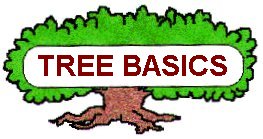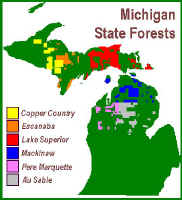

MICHIGAN FORESTS FOREVER TEACHERS GUIDE
| MICHIGAN'S STATE FOREST SYSTEM |
 |
A Short History of
the Michigan State Forests: The Early Days
By Mike Moore
On my office wall I have a photograph of Gifford Pinchot, first American forester and one of the seven founding members of the Society of American Foresters. I often think of his writings, especially in Breaking New Ground where he wrote In 1876, my Father took me to the Centennial Exposition at Philadelphia, held to celebrate the hundredth birthday of the richest forest country on earth. It contained no forest exhibit of any sort or kind except for the single State of Michigan. The State Centennial Board of Managers published a description of that exhibit. It states there were more than 1200 specimens on display comprising trunks and cross-sections of trees, blocks, boards, natural curiosities in growth , shrubs, seeds. It also stated that accompanying the Exposition Catalogue was a valuable paper by Professor W.J. Beal, of the State Agricultural College, and quotes from the paper; " To the best of my knowledge, lumbering has always been overdone in this State."
 Michigan's forest heritage dates to
before Statehood. The first Federal Land Office was established in Michigan in
1814 and the first mill in the Upper Peninsula was built by the US Army at Sault
Ste. Marie in 1822. It was during this period that settlers began to move into
Michigan, especially following the opening of the Erie Canal in 1825. The
landscape was covered with pine.
Michigan's forest heritage dates to
before Statehood. The first Federal Land Office was established in Michigan in
1814 and the first mill in the Upper Peninsula was built by the US Army at Sault
Ste. Marie in 1822. It was during this period that settlers began to move into
Michigan, especially following the opening of the Erie Canal in 1825. The
landscape was covered with pine.
The Government Land Office survey of Michigan was completed in 1853. White Pine logging started in the mid 1830s and reached its zenith around 1900. The rapid and thorough exploitation of this resource led to the establishment of the Independent Forestry Commission in 1887. This commission consisted of the members of the State Board of Agriculture and its duties were to institute an inquiry into the extent to which the forests of Michigan were being destroyed by fires, used by wasteful cutting for consumption or for the purpose of clearing lands for tillage or pasturage. Also as to the effect of diminution of the wooded surface of the lands upon ponds, rivers and water power of the State, and in distributing and deteriorating the natural conditions of the climate. Also as to the protection of denuded regions, stump and swamp lands. No small task! The Commission issued a report in 1888 and a forestry convention was held at Grand Rapids the same year, under the auspices of the commission. Numerous interesting papers were read and addresses made. Among them was an address by Professor B. E. Fernow, in which he called for strong legislation to protect and manage forest land but he warned that ignorant legislation is criminal legislation. Unfortunately the law that created the Forestry Commission was repealed in 1892, apparently in an effort to save money. Later, in 1893 a General Property Tax Law was enacted. It gave taxing power to the state and enabled foreclosure on tax delinquent cutover lands. This Act was to have a major influence on the establishment and growth of Michigan's State Forests.
In the fifty-sixth annual report of the Commissioner of the Land Office (William A. French) of the State of Michigan for the fiscal year ending June 30, 1898 it states Michigan should be foremost of all states of the United States in encouraging forestry, yet we find that little, if any, attention is being given to the preservation or restoration of our forest, which have been a leading factor in producing the wealth of the State.
The State Forestry Commission was reestablished by law in 1899. Public officials began to recognize that some land should be retained in public ownership. Logged over lands were considered worthless to their owners. Many acres reverted to State ownership. Farmers and settlers who tried to make the northern sandy soil lands productive for agriculture were largely unsuccessful and most farms failed. Forest fires devastated thousands of acres.
In 1903, 34,000 tax reverted acres in Roscommon and Crawford counties were set aside for forestry purposes, and were dedicated as the Higgins Lake, and Houghton Lake State Forests. Reforestation by the planting of nursery stock was begun in 1904, with the first stock coming from commercial dealers.
Professor Filibert Roth was appointed Forest Warden in September, 1903 and compensated at the rate of $1,000 per year. He was authorized to negotiate for additional lands, to give free permits for wild hay, to dispose of dead and down timber (valued under $10 and for domestic use) and to employ forest rangers. Forest fire control became a major item of concern, especially through the construction of fire lanes.
In 1904 Filibert Roth authored the Michigan Forest Reserve Manual for the Information and Use of Forest Officers. In this Manual, he outlines the objects of the Forest Reserves: 1. To protect and improve the forest cover and thereby produce a crop of timber on lands which are largely unsuited to other kinds of crops. 2. To encourage settlement by lessening the dangers from fire and by restoring to the land the attractive and useful cover. 3. To encourage by direct help and good example, better protection of private lands. 4. To regulate the use of these lands and such materials as they now offer, especially to regulate the grazing upon these lands to avoid useless, destructive overgrazing. 5. To assure to the county and town at least some return in place of regular taxes. The law now provides that the State through its Forestry Commission may contribute to the maintenance of roads and schools in the towns where the Forest Reserves are located. 6. To furnish employment in the protection and care of the forests.
Warden Roth summed up his thoughts on the actions of the employees of the Commission: Keeping in mind the objects and purposes of the reserves and their forests, it is clear that the first and foremost duty of every forest officer is to care for the forest, and every act, every decision he is called upon to make, should be guided by the thought: Will it improve and extend the forest?
In 1907 Governor Fred M. Warner appointed a special Commission of Inquiry on Tax Lands and Forestry. Among other things the Commission recommended a reorganization of state government agencies related to forests and forestry. This resulted in Act 289 of Public Acts of 1909 establishing a Public Domain Commission. One of their first actions was to hire Mr. Marcus Schaaf as State Forester. Mr. Schaaf was a graduate of Dr. Carl A. Schencks Biltmore School of Forestry located in Pisgah, North Carolina. Additional Forest Reserves opened under Mr. Schaafs leadership include Fife Lake and Lake Superior in 1913, Ogemaw in 1914, Presque Isle in 1915, and Alpena in 1916. The State Forest System was underway. By 1916, of the some 600,000 acres in state ownership, seven state forests had been designated, including one in the Upper Peninsula for a total of 113,271. The remainder of the State owned lands were undedicated. Originally the duties of the forest officers were fire protection, land surveying and tree planting.
Significant changes occurred in the ensuing decades. The Department of Conservation was created in 1921, the Land Economic Survey began work in 1922, and massive tax reversions of land became commonplace in the 1930s. By 1938, 12 State Forests encompassing 1,049,042 acres were managed for servicing of recreation and the production of timber. State ownership continued to grow, both by reversions, and by purchase. Special wildlife funds were used to purchase game areas throughout northern Michigan that were intertwined with State Forests and resulted in inefficient management and confusion. On July 1, 1946, the Conservation Commission rededicated all northern lands as State Forests. In 1950, there were 3,685,000 acres of ownership in 22 State Forests. Timber receipts totaled $149,000. It should be noted that the salvage of dead and down timber was authorized from the earliest days of the state forests. However, it wasn't until 1935 that legislation was passed expanding this authority to standing live timber. How interesting to note the value increase of harvested materials from under $150,000 annually in 1950 to over $25,000,000 in 2000!
It's time to leave the story until another time. But it is clear that the professional and loving care provided by a succession of foresters during the twentieth century have made the Michigan State Forest system one of the primary providers of outdoor recreation, habitat protection, and sustained timber products in the State of Michigan.
Michigan's forest dominated the landscape for centuries. In the 1800s, settlement, farming, logging, and forest fires changed the landscape dramatically. Farming mostly failed on the poor sandy soils of northern Michigan and logging removed forest cover. Whatever the reason, the landscape was left with dead wood or slash and vulnerable to intense forest fires. In 1871, fires burned approximately 2.5 million acres. Over 1 million acres burned in the Thumb in 1881. Fires destroyed trees, habitat, killed wildlife, and accelerated erosion and river/stream degradation.
In 1887, the State of Michigan established a Forestry Commission to preserve, protect, and restore Michigan's forests. The Commission was later dissolved. In 1889, the Forestry Commission was re-established. The Forestry Commission started nurseries for seedlings and stressed that fire protection was imperative to good forest management. In 1902, Michigan Agricultural College (now Michigan State University) established a Forestry curriculum for education, training, and research. The University of Michigan (1902) and Michigan Technological University (1936) established programs as well.
In 1903, the Forestry Commission established the first state forest in Crawford and Roscommon counties. Over the next 100 years the state forest system grew from 34,000 acres to nearly 4 million acres. It's vegetation changed dramatically as well, transforming from cutover and burned-over abandoned land to a vibrant, healthy, growing forest.
Today, Michigan's landscape is again dominated by forests, covering a little over half the State. These 19.3 million acres of forest land support a diversity of ecosystems, trees, animals, birds, fish, provide outdoor recreation, protect air and water quality, support local communities and forest industry, and enhance the quality of life in Michigan.
 |
This website was developed and created by Michigan State University Extension for the teachers of the State of Michigan. |